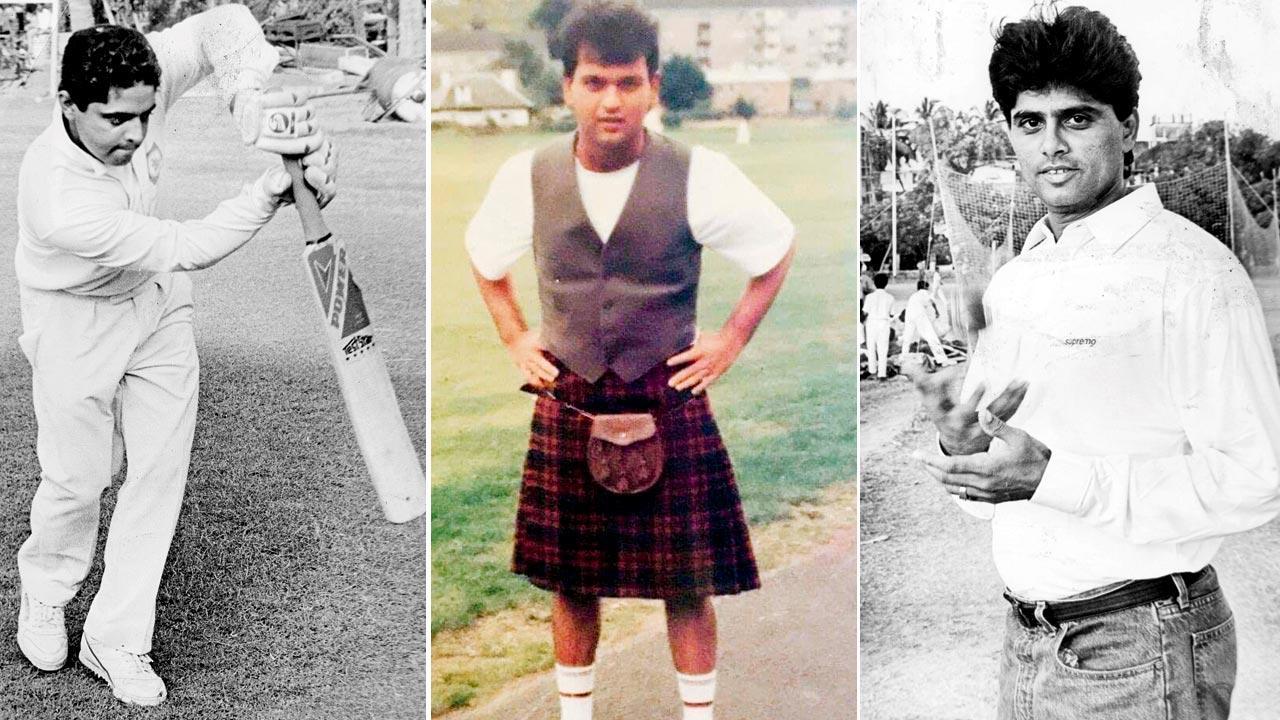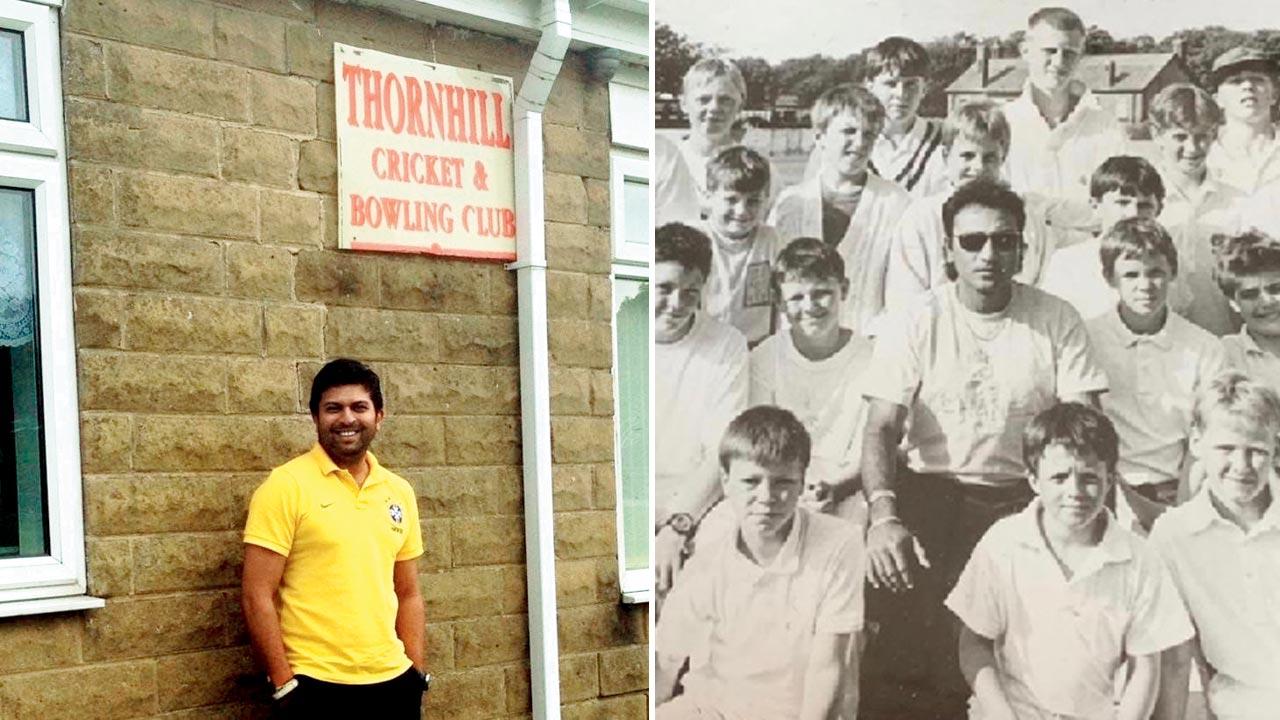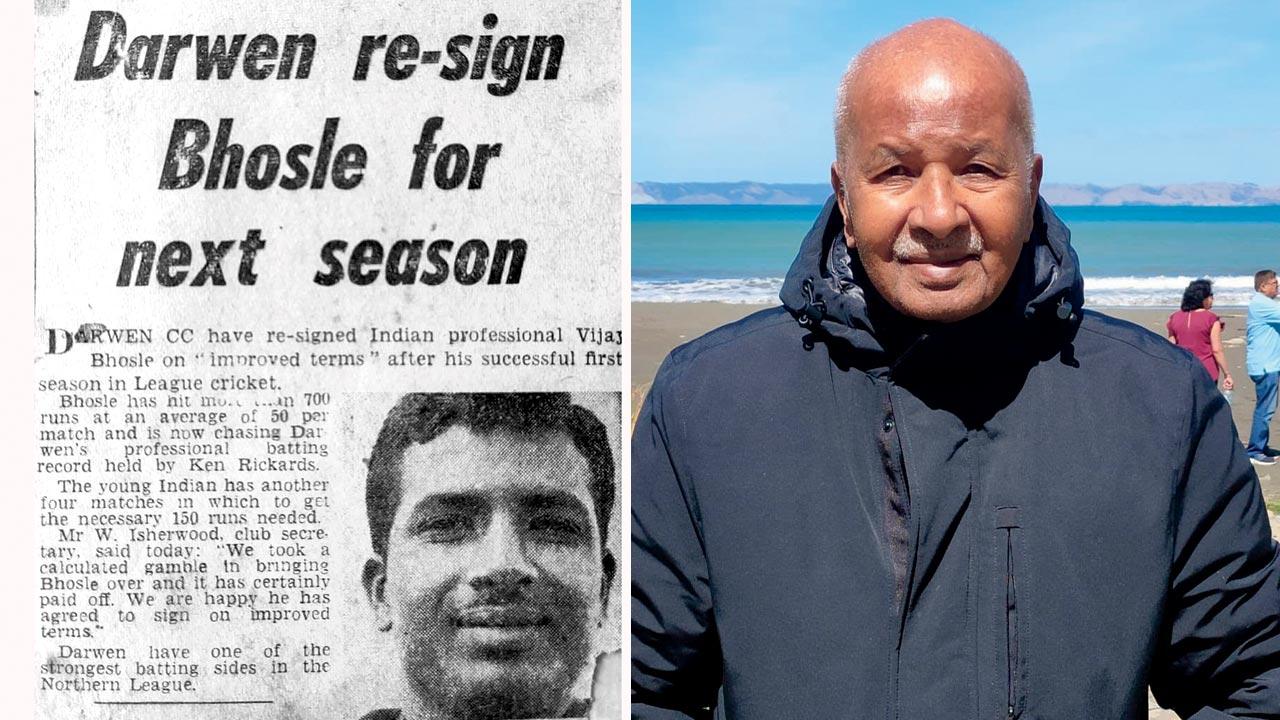As the curtain comes down on IPL-17 tonight, mid-day goes back in time to when India’s domestic cricketers used this off-season to learn and earn on the greens on England and Scotland

Zubin Bharucha; Shishir Hattangadi in Scotland; Raju Kulkarni. Pic/mid-day archives
By this time of the year in the pre-Indian Premier League cricket era, Ranji Trophy cricketers from Mumbai would have had their teeth into league cricket commitments in the United Kingdom, where a platform to enhance skills and raise monetary stocks was on offer.
The glitzy T20 tournament which world cricket dances to these days, has in a way changed the dynamics of the cricket season. However unbelievable it may sound, the months of April and May heralded the off-season for competitive cricketers. The Ranji Trophy would generally end in March, at most April, although one of the most thrilling of Ranji Trophy finals—Mumbai v Haryana in 1991—was held in May. For Ravi Shastri, his county commitment to Glamorgan prevented him from being part of that particular season’s climax, made famous by the Kapil Dev-led team’s narrow win for a maiden Ranji triumph.
There was a bit of glamour involved in cricketers flying out to England. It lit a flame of ambition among the younger lot coming through the ranks as well.
 Jatin Paranjape (left), Sairaj Bahutule and Paras Mhambrey indulge in some leg-pulling. Pic/mid-day archives
Jatin Paranjape (left), Sairaj Bahutule and Paras Mhambrey indulge in some leg-pulling. Pic/mid-day archives
The 1980s and 1990s saw a good number of Mumbai players in English leagues. But it was not unprecedented. Batting great Vijay Manjrekar, the father of batsman-turned-commentator Sanjay, was a regular in the leagues and so was celebrated all-rounder Vinoo Mankad and leg-spin titan Subhash Gupte.
One of the most fascinating stories concerning the great Mankad had a league cricket connection to it. In February 1952, Mankad claimed 12 wickets to give India its first-ever Test match triumph–against the MCC (England toured under the Marylebone Cricket Club banner till 1976-77). In two months’ time, Vijay Hazare’s Indian team were scheduled to tour England for a four-Test series. Mankad wanted an assurance from the selectors that he would be taken on the tour because Haslingden Cricket Club offered him a contract which was worth £1,200. The BCCI couldn’t guarantee him a spot, so Mankad went ahead and played for Haslingden. He didn’t want to put club before country, but couldn’t afford to be left in the lurch either—missing out on a league contract and not playing for India on tour. The Indian team began the tour in disastrous fashion. Haslingden was requested by the Indian team bosses to release Mankad. The Lancashire club laid down three conditions--£100 pounds to be paid to Mankad, £200 to the club and a suitable professional be made available for the club in the absence of Mankad. The all-rounder arrived for the opening Test at Leeds, but Haslingden’s conditions were not met, so Mankad could only watch as his India team lost by seven wickets. A settlement was reached for the second Test at Lord’s, a game which has gone down in cricket folklore as ‘Mankad’s Test.’ Although the Indian team could not avoid defeat, Mankad scored 72 and 184 while opening the innings apart from claiming 5-196 in England’s first innings.
In November 1962, Mankad recommended Maharashtra and Baroda first-class batsman Vijay Bhosale to a Lancashire League club called Darwen. The prolific batsman (who also played for Mumbai) wore Darwen colours for two seasons in 1963 and 1964. Bhosale, 86, who is currently in New Zealand, recalled getting £400 to £500 for the season and a £300 hike the following year. Bhosale’s consistency impressed the club authorities. In his first year, he fell short by 30 runs to become their highest-scoring professional in a season. The following year, he surpassed West Indian professional Ken Richards’s 848 record runs to go down as a remarkable heavy scorer in the club’s history. When not wielding his willow on the league greens, Bhosale worked for Belgrave Wallpaper there.
 A newspaper clipping of Sameer Dighe (kneeling second from right) with his Ossett CC teammates
A newspaper clipping of Sameer Dighe (kneeling second from right) with his Ossett CC teammates
In the late 1980s, Mumbai Ranji Trophy batsman Zubin Bharucha arrived at Reigate Priory CC in Surrey to begin a decade-long playing association with the club. “I was introduced to the club through Parsee Cyclists [a club in Mumbai] teammates Firdaus Shroff and Rohinton Iranpur, who was particularly keen I go and play in England. It was very kind of Firdaus to make way for me to play at Reigate CC, a very magnanimous decision by him at the time. I never played for any other club,” said Bharucha, 54, who is now Rajasthan Royals’s Director of High Performance. It is here where he set things in motion for a successful coaching career. “While at Reigate Priory, I got together with a group of fellow youngsters and started a firm which undertook odd jobs like painting and grass-cutting. A lot of the commercial work was done through the night and we had to finish before the mall opened the next morning. It was all great fun and quite a diverse set of learnings for someone coming from Mumbai and not exposed to this way of life,” he added.
After displaying his batting and quicksilver fielding skills for Reigate, Bharucha was asked if he would be a sports teacher at a small prep school at Banstead, a town near Reigate. “Obviously, it [the job] involved cricket and that’s when my cricket coaching career kicked off. I was 17 at the time and coaching 15-year-olds,” he revealed.
Meanwhile, the club prospered from a team languishing at the bottom of the table in Division 2 to a premiership team flush with players who went on to play first-class cricket including Jason Roy, who played a good hand in England’s ODI World Cup triumph in 2019. Bharucha recommended leg-spinner Sairaj Bahutule to Reigate, a club the former India leg-spinner played for a number of years.
 Jatin Paranjape at Thornhill; (right) Alan Sippy with the kids he coached in the UK. Pic/Alan Sippy Collection
Jatin Paranjape at Thornhill; (right) Alan Sippy with the kids he coached in the UK. Pic/Alan Sippy Collection
Apart from lessons learnt while playing in English conditions, Bahutule developed as a person. “A lot of understanding of yourself takes place in those months spent in England. The five months teach you get yourself organised because you’ve got to do everything yourself. You start being independent,” said Bahutule, 51, who stayed away from part-time jobs because cricket had to be his focus.
Paras Mhambrey, the current India bowling coach recalled spending no less than eight seasons in England. His days at Maidenhead Cricket Club, near London, were most memorable. He also played in Huddersfield, Yorkshire, and spent a few nights working at a petrol pump. Mhambrey revealed that money was an issue in the initial years, but as one’s performance and reputation grew, the returns turned handsome. The pressure of being the club’s only professional can be daunting. “As a pro, you are expected to perform. You had to perform for your next year’s contract. Other clubs would notice your performance and an offer could well come along. You’d never know which club would be looking for a pro for their next season,” said Mhambrey, 51, who ended up making his Test debut in England in 1996.
With no restriction on the number of overs a bowler can bowl in limited overs cricket, Mhambrey revealed there were occasions when he had to bowl a massive amount of overs. “Your skills were covered, rhythm and workload too, so, going to England helped your game. And then you returned to India in time fit and ready for our domestic season,” stressed Mhambrey, who used to carry a pressure cooker and recipes to keep his Indian taste buds happy.
 A 1963 newspaper clipping from Vijay Bhosale’s collection; (right) A recent photograph of Vijay Bhosale
A 1963 newspaper clipping from Vijay Bhosale’s collection; (right) A recent photograph of Vijay Bhosale
Raju Kulkarni, the fast bowler, who went out of the game in the season Mhambrey made his debut for Mumbai under Sanjay Manjrekar in 1992-93, also featured regularly on the English greens. During the Indian monsoons, Kulkarni, who figured in Tests against Australia and Pakistan in 1986-87, was able to sort out chinks in his armour, get physically fitter and play on tirelessly. Some of his trips were funded by the house of Mafatlals, the team he initially played for in the Times Shield before Tata Sports Club. Kulkarni’s trips will be chiefly remembered for two incidents as relayed to this writer on mid-day’s Mumbai Cricket Podcast. Kulkarni helped out in the India nets and watched the Indian team play in Scarborough on their 1986 tour of England. A friend who was to drop captain Kapil Dev and his wife Romi to London offered to give Kulkarni a lift to his Yorkshire home. After the two-hour drive, they took a break in Kulkarni’s accommodation. Romi prepared some toast while Kapil helped make the tea. As the cricket star got ready to enjoy his cuppa, in walked Kulkarni’s room partner. He couldn’t believe his eyes and ran off to tell everyone in the area that the India captain was drinking tea at his house.
The other incident is not as pleasant. Kulkarni was playing in a must-win league game in Scotland. He gave a batsman some chin music and one delivery hit him on the head. Kulkarni and his teammates went up to the batsman to check what damage he had suffered. Soon, they saw a woman sprinting towards them. When she confronted Kulkarni, he discovered that it was the injured batsman’s wife. “She tried to slap me and told me that she was watching me for a while and accused me of trying my best to injure her husband. Someone stopped her from slapping me,” said Kulkarni.
A president of a cricket club who was keen on photography captured the event and supplied the footage to the BBC.
One of Kulkarni’s English summers were spent with Shishir Hattangadi in a caravan. Like his Tata Sports Club teammate, Hattangadi too went on to captain Mumbai. Apart from the pressure to perform weekend after weekend, the stocky former opener remembered how packing up and leaving immediately after a game was not appreciated by the club bigwigs. “I was told that I must socialise with the members after the game and buy rounds of drinks for them. Through this tradition I ended up gulping down several glasses of orange juice,” recalled Hattangadi who played for Forfarshire CC in the Scottish league.
When not displaying his tight technique, Hattangadi did groundsman duty whenever the regular curator was on leave, worked at the bar and coached kids. “One of the challenges was to ward off any over-confidence while facing not-so-great bowling and respect the conditions,” he said.
Hattangadi’s Tata Sports Club teammate, Alan Sippy wore Furness CC in the North Lancashire League. He told us that he enjoyed every bit of it and never felt “lost or lonely.”
On non-match days, southpaw Sippy mowed lawns and delivered medical supplies to the local hospital. Sameer Dighe, the former India and Mumbai captain, who led the city to their 1999-2000 Ranji Trophy triumph, spent 16 years playing for different clubs in the Bradford, Huddersfield and Central Yorkshire leagues in the 1990s. For him, Bradford was the toughest league, but his “eight to nine years” for Ossett CC in Central Yorkshire were rewarding.
Dighe expressed his interest in playing league cricket to Milind Rege, the former Mumbai captain who had roped him in as a youngster for Tata Sports Club. “Rege Sir was kind enough to have a word with Sunil Gavaskar Sir. He spoke to someone in Yorkshire and I got a club to play for. I’m also grateful to Rege Sir for the permission to play in the UK, because I knew a lot of players from Chennai who were not allowed to play in England while being employed,” said Dighe, who figured in the third and final Test of the historic 2001 Test series against Australia in Chennai.
Jatin Paranjape played one-day international cricket for India in 1998. He impressed the English with his sublime batting while playing in Yorkshire. For him, dealing with homesickness was, “a real challenge especially when the weather was cold and rainy.”
Left-handed Paranjape batted for Thornhill CC in the Central Yorkshire League and Yorkshire Bank CC in the Bradford League.
Though the IPL is a welcome avenue for Indian cricket’s domestic toilers to perform in cutting edge competition, if these former players got a chance to do it all again, they would. There would be no hesitation to get on a plane, arrive, settle down for a club stint and, depending on where they play, either listen to some Scottish bagpipes or sing, ‘Oh, to be in England.’
 Subscribe today by clicking the link and stay updated with the latest news!" Click here!
Subscribe today by clicking the link and stay updated with the latest news!" Click here!










